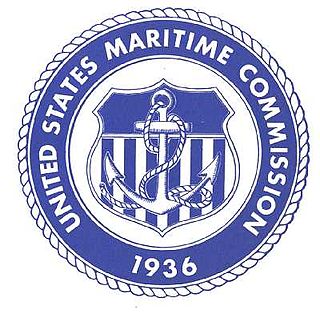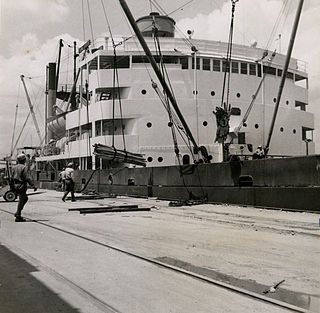SS Spitfire may refer to a former United States Navy oiler, or to one of two Type C2-S-B1 ships built for the United States Maritime Commission:
Type C2 ships were designed by the United States Maritime Commission (MARCOM) in 1937–38. They were all-purpose cargo ships with five holds, and U.S. shipyards built 173 of them from 1939 to 1945. Compared to ships built before 1939, the C2s were remarkable for their speed and fuel economy. Their design speed was 15.5 knots (28.7 km/h), but some could make 19 knots (35 km/h) on occasion. The first C2s were 459 feet (140 m) long, 63 feet (19 m) broad, and 40 feet (12 m) deep, with a 25-foot (8 m) draft. Later ships varied somewhat in size.

The United States Maritime Commission (MARCOM) was an independent executive agency of the U.S. federal government that was created by the Merchant Marine Act of 1936, passed by Congress on June 29, 1936, and replaced the United States Shipping Board which had existed since World War I. It was intended to formulate a merchant shipbuilding program to design and build five hundred modern merchant cargo ships to replace the World War I vintage vessels that comprised the bulk of the United States Merchant Marine, and to administer a subsidy system authorized by the Act to offset the cost differential between building in the U.S. and operating ships under the American flag. It also formed the United States Maritime Service for the training of seagoing ship's officers to man the new fleet.
- SS Spitfire (1942), built by Sun Shipbuilding & Drydock in Chester, Pennsylvania as Esso Columbia; commissioned as USS Atascosa (AO-66), later Esso Syracuse, forepart combined into Esso Buffalo and, converted to a bulk carrier, Spitfire; scrapped in 1973.
- SS Spitfire (1943) (MC hull number 1160), built by Moore Dry Dock in Oakland, California; later became USS Capricornus (AKA-57/LKA-57); scrapped in 1985
- SS Spitfire (1946) (MC hull number 2818), built by Consolidated Steel in Wilmington, California; scrapped in 1975

Chester is a city in Delaware County, Pennsylvania, United States. With a population of 33,972 at the 2010 census it is the largest city in Delaware County. Incorporated in 1682, Chester is the oldest city in Pennsylvania and is located on the western bank of the Delaware River between the cities of Philadelphia and Wilmington, Delaware.
USS Atascosa (AO-66) was an Atascosa-class fleet oiler acquired by the U.S. Navy for use in World War II. She had the dangerous task of supplying fuel and ammunition to ships in and near, combat areas in both the Atlantic Ocean and the Pacific Ocean.

Oakland is the largest city and the county seat of Alameda County, California, United States. A major West Coast port city, Oakland is the largest city in the East Bay region of the San Francisco Bay Area, the third largest city overall in the San Francisco Bay Area, the eighth most populated city in California, and the 45th largest city in the United States. With a population of 425,195 as of 2017, it serves as a trade center for the San Francisco Bay Area; its Port of Oakland is the busiest port in the San Francisco Bay, the entirety of Northern California, and the fifth busiest in the United States of America. An act to incorporate the city was passed on May 4, 1852, and incorporation was later approved on March 25, 1854, which officially made Oakland a city. Oakland is a charter city.
| This article includes a list of ships with the same or similar names. If an internal link for a specific ship led you here, you may wish to change the link to point directly to the intended ship article, if one exists. |

